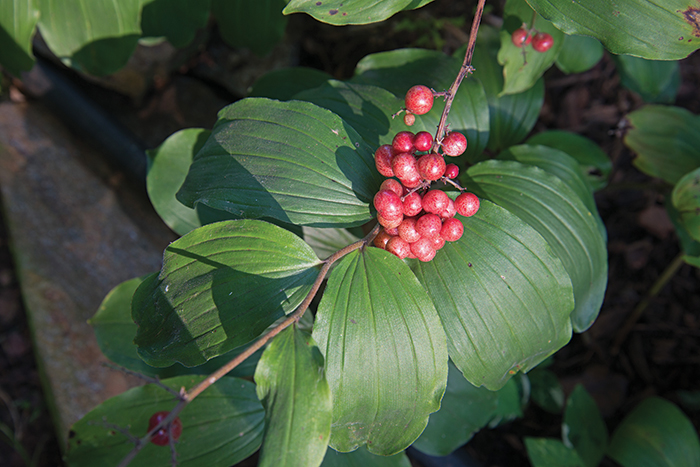I have three Solomon’s seals in my yard. No, not three plants, but rather three different types of Solomon’s seal. All of them are dependable performers in shadier parts of my growing grounds, and none are particularly hard to find this time of year at local garden centers.
Allow me to introduce them:
Solomon’s Seal (Polygonatum biflorum). This cutie is native to the woodlands of North Carolina as well as other areas of the eastern United States. An herbaceous perennial, it makes a flowing statement in shady cultivated gardens with green ovate leaves riding on curved branches up to 3 feet tall and wide.
In the spring, rows of bell-shaped, light green to white flowers delightfully dangle in pairs underneath the arching limbs, and these blossoms develop into small, blue, fleshy berries by summertime. Come autumn, the foliage salutes the growing season’s end by turning a pleasing butter yellow.
As is typical with most commonly available Solomon’s seals, they will slowly colonize and spread in the right conditions, which include rich, acidic soil with a strong organic base to help retain an even supply of moisture, and a planting site located in part to full shade.

Variegated Solomon’s Seal
Variegated Solomon’s Seal (Polygonatum odoratum ‘Variegatum’). An import from the Orient, this graceful plant is just what the landscape doctor ordered for a good dose of “Yipes! Stripes!” to a shady nook. Of similar stature and performance as our native Solomon’s seal, it brings more eye candy to a garden party with cream-colored streaks along the lengths of its leaves, which help to break up the ho-hum sea of green common in many Southern shade gardens. This snappy dresser was named the Perennial Plant Association’s 2013 Perennial Plant of the Year.
False Solomon’s Seal (Maianthemum racemosum). Although not in the same genus as true Solomon’s seals, this close cousin is a North American native with the look and grace of Polygonatum biflorum. The two are sometimes found paired in the wild, meaning it also thrives in similar growing conditions. So, what’s the difference? Instead of bell-like flowers hanging from under the stems, false Solomon’s seal shows off feathery bloom clusters on the tips of its limbs. These blossoms give way to red berries that can ripen to a bright red, but, personally, I usually don’t see them in such a hot hue — the birds in my garden eagerly gobble up the maturing fruits!
In April
For fancier flower displays from backyard pond pretties such as water lily and lotus plants that require a steady diet of nutrients from spring into the summer, adding time-release fertilizer tablets specially formulated for potted aquatic plants to their containers should do the trick.
Cool-season vegetables that were seeded in the garden last month should now be thinned to their proper spacing requirements.
Early bird veggie gardeners can begin planting summer vegetables such as corn, cucumbers, cantaloupes, tomatoes, pumpkins, snap beans, squash and watermelons by the middle to end of this month.
Remember to set aside an area for the little gardeners in your family. Show them how to prepare the soil, and then help the tykes grow easy annuals like sunflowers, zinnias, pole beans or pumpkins.
If you haven’t given your dog or cat a flea and tick treatment in the last month, put any of their brushings around the bird feeder, and see how fast the fuzz gets snatched up for building nests. And while it might be tempting to also add dryer lint, don’t. It could contain residual cleaning chemicals that can be unsafe for birds.
Standard springtime pretties such as azaleas, spring-flowering climbing roses, camellias (Camellia japonica), forsythias, dogwoods and many more can be pruned after they have finished their bloom time. Use hand pruners or loppers to individually cut any overreaching branch back to a bud or limb junction.
- Revelry Resonates
- Great Catch
- In Full Bloom
- Crude Extraction from Oaklyn Springs Brewery
- Flying Pepper Tobago Infused Vodka
- LeeAnn Plumer
- I Went On A Dump* Tour, This Is What Happened
- No Place Like Home: South Lakes
- Sing a Song of Solomon’s Seals
- Discover Manteo’s Timeless Appeal
- The Untold Story of Raven Rock State Park







